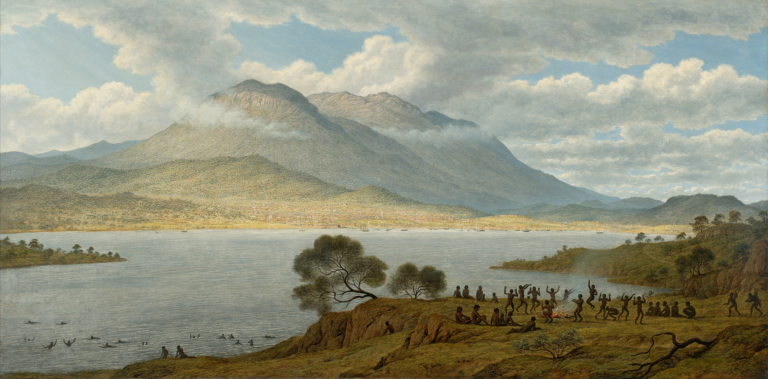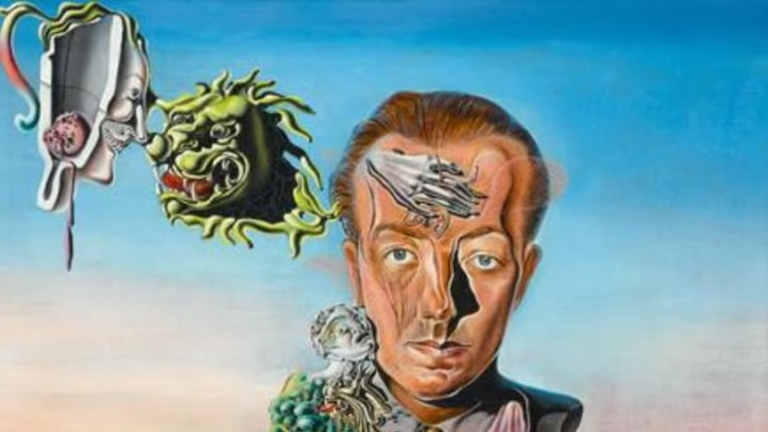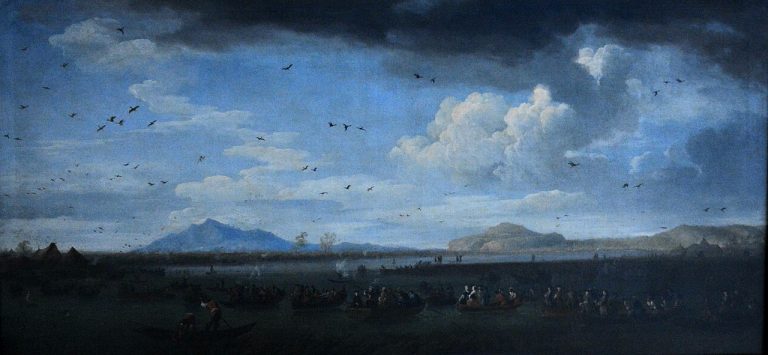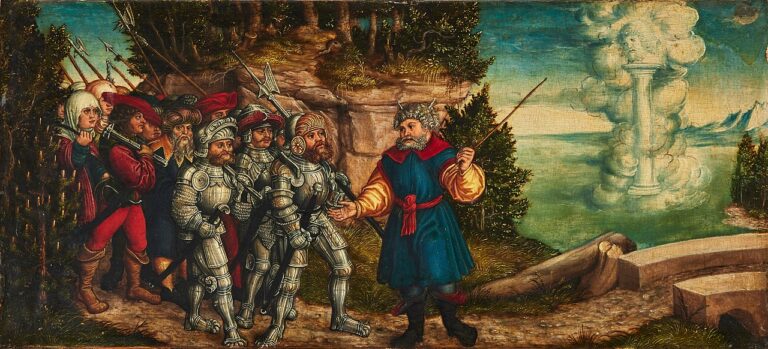Rembrandt van Rijn Painter: The Dutch Master Who Revolutionized Baroque Art
Born: July 15, 1606; Leiden, Netherlands
October 4, 1669; Amsterdam, Netherlands
Art Movement: Baroque, Dutch Golden Age
Nationality: Dutch
Influenced By: Peter Paul Rubens, Caravaggio, Titian, Adam Elsheimer, Caravaggisti
Institution: Dutch School
Rembrandt van Rijn Painter: The Dutch Master Who Revolutionized Baroque Art
Biographical Overview
Rembrandt Harmenszoon van Rijn (1606-1669) lived a life as dramatic and nuanced as his paintings. His journey from a miller’s son to one of the greatest artists in Western history was marked by early success, personal tragedy, and financial ruin.
Early Life and Education in Leiden
Born on July 15, 1606, in Leiden, Netherlands, Rembrandt was the ninth child of miller Harmen Gerritsz van Rijn and Neeltgen van Zuytbrouck. His family was relatively comfortable, allowing him to attend Latin school and enroll at Leiden University at age 14, though he soon abandoned academic studies to pursue art.
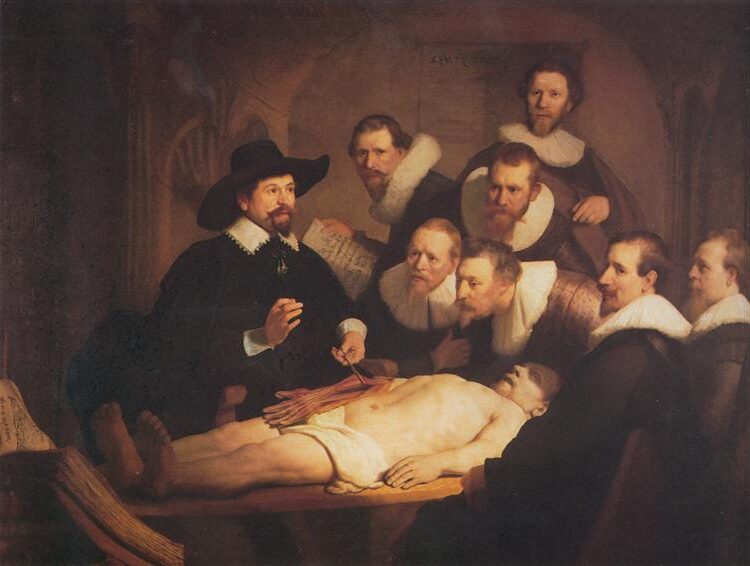
The Anatomy Lesson of Dr. Nicolaes Tulp (1632) by Rembrandt
Rembrandt apprenticed with local painter Jacob van Swanenburgh for three years, learning the fundamentals of painting. He later spent six months with the renowned historical painter Pieter Lastman in Amsterdam, whose influence on Rembrandt’s narrative style proved significant.
By his early twenties, Rembrandt had established himself as a professional artist in Leiden. He opened a studio and began taking on students, including Gerard Dou who became a famous painter in his own right.
Amsterdam: A New Chapter
In 1631, Rembrandt moved to Amsterdam, the commercial capital of the Netherlands. This strategic relocation connected him with wealthy patrons and expanded his professional opportunities.
He initially worked with prominent art dealer Hendrik van Uylenburgh, whose cousin Saskia he would later marry.
The 1630s marked Rembrandt’s rise to prominence. He received numerous portrait commissions from Amsterdam’s elite and created dramatic biblical scenes that showcased his masterful use of light and shadow. His painting “The Anatomy Lesson of Dr. Nicolaes Tulp” (1632) established him as the city’s most fashionable portrait artist.
Rembrandt purchased an expensive house on Breestraat (now Jodenbreestraat) in 1639, which today houses the Rembrandt House Museum. This property would later factor into his financial downfall.
Personal Life and Relationships
Rembrandt married Saskia van Uylenburgh, from a wealthy Frisian family, in 1634. Their marriage brought social connections and financial stability. The couple had four children, but only Titus survived to adulthood. Saskia died in 1642, likely from tuberculosis, shortly after Titus’s birth.
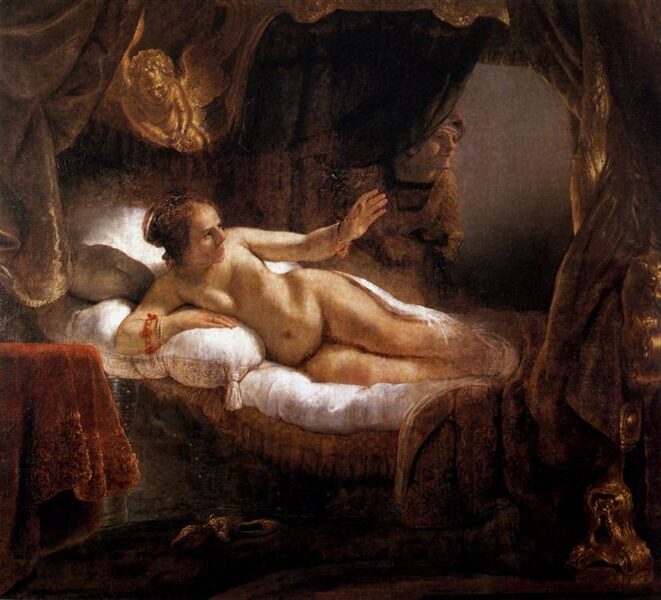
Danae (1643) by Rembrandt
After Saskia’s death, Rembrandt hired Geertje Dirckx as a nurse for Titus. Their relationship became intimate but ended in legal disputes. Later, Hendrickje Stoffels entered his household as a servant and became his common-law wife. They couldn’t marry legally because of financial stipulations in Saskia’s will.
Despite personal tragedies, Rembrandt found stability with Hendrickje and their daughter Cornelia. His later years were marked by financial troubles, including bankruptcy in 1656, but his artistic vision only deepened. Rembrandt continued creating profound works until his death in 1669.
Artistic Mastery and Style
Rembrandt van Rijn’s artistic genius lies in his unique approach to light, shadow, and human emotion. His techniques evolved throughout his career, creating a distinctive style that influenced generations of artists after him.
Signature Techniques of Rembrandt
Rembrandt’s mastery of chiaroscuro—the dramatic contrast between light and dark—defines his most iconic works. He used thick layers of paint (impasto) to create texture and dimension, particularly in areas where light would naturally reflect, such as jewelry or facial features.
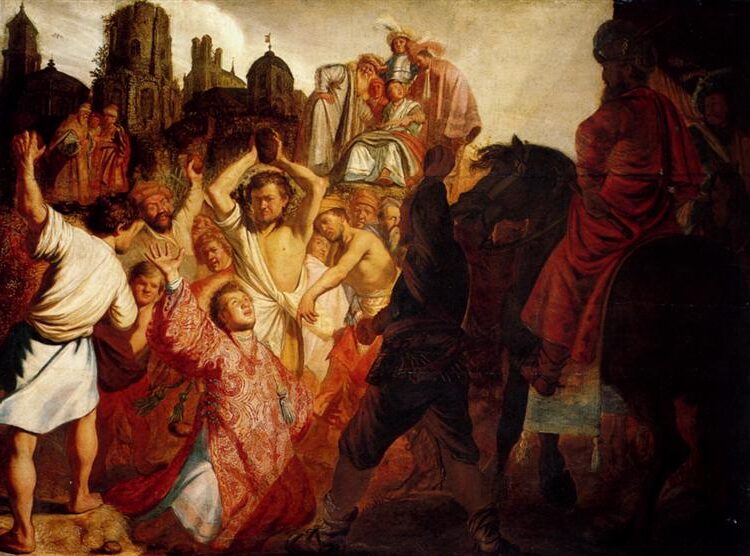
The Stoning of St. Stephen (1625) by Rembrandt
His brush strokes evolved from smooth and precise in his early years to looser and more expressive in his later works. This evolution shows his growing confidence and artistic freedom.
Rembrandt’s use of light wasn’t just technical—it was emotional. He directed light to highlight psychological aspects of his subjects, creating intimate, thoughtful portraits that seemed to reveal the inner life of the person.
As a draftsman and etcher, Rembrandt also mastered these mediums, making him a truly universal artist who excelled across all forms of visual expression.
Notable Works and Contributions
“The Night Watch” (1642) stands as one of Rembrandt’s most significant paintings, showcasing his ability to arrange multiple figures in dynamic composition while maintaining psychological depth for each character.

The Nightwatch (1642) by Rembrandt
His history paintings demonstrated his ambitious scope, including “The Conspiracy of Claudius Civilis” and “The Return of the Prodigal Son,” which combines dramatic biblical storytelling with profound human emotion.
Rembrandt reached his first artistic peak in the late 1620s, but continued to develop his style throughout his career. His work spans religious scenes, mythology, landscapes, and intimate portraits.
His etchings were as influential as his paintings. These meticulously crafted works showed his exceptional skill in creating depth and texture using only line work.
The Portraitist and His Subjects
Rembrandt painted over 80 self-portraits throughout his life, creating an unprecedented visual autobiography that tracked his appearance, skill, and emotional state over time.


His portrait commissions reveal his ability to capture both physical likeness and character. Unlike many contemporaries, Rembrandt didn’t flatter his subjects but instead revealed their humanity and complexity.
He painted people of all social classes with equal dignity and psychological insight. His subjects appear contemplative and alive, caught in moments of authentic human experience.
Rembrandt’s portraits often feature ordinary people in extraordinary light. He painted merchants, scholars, and everyday citizens with the same careful attention he gave to wealthy patrons.
His influence as a portraitist extended throughout Europe, setting new standards for what a portrait could reveal about the human condition.
Legacy and Influence
Rembrandt van Rijn’s artistic contributions extend far beyond his lifetime, shaping the course of Western art history. His innovative techniques and emotional depth continue to inspire artists and captivate audiences worldwide.
Rembrandt’s Impact on European Art
Rembrandt’s influence on European art remains profound nearly four centuries after his death. As a master of the Dutch Golden Age, his revolutionary approach to light, shadow, and human expression transformed portraiture and historical painting.

History Painting (1626) by Rembrandt
His techniques inspired generations of artists who studied his works. Painters like Aert de Gelder, his last pupil, carried forward his dramatic use of light and emotional depth in their own compositions.
Rembrandt’s reputation as a history painter who brought biblical and mythological scenes to life with unprecedented humanity influenced how later artists approached these subjects. His innovative printmaking techniques also advanced this art form significantly.
Modern artists continue to reference his distinctive style, particularly his mastery of chiaroscuro and psychological insight in portraiture. Art academies worldwide still teach students to study Rembrandt’s methods as foundational knowledge.
Preservation and Exhibition
Major museums around the world proudly display Rembrandt’s works in prominent positions. The Rijksmuseum in Amsterdam houses the largest collection of his paintings, including “The Night Watch,” which underwent careful restoration to preserve its brilliance.
The Rembrandt House Museum, located in his former home on Jodenbreestraat in Amsterdam’s Jewish Quarter, offers visitors a glimpse into his life and working methods. The museum has meticulously recreated his studio based on historical records.
Other significant collections can be found at:
- The National Gallery, London
- The Louvre, Paris
- The Metropolitan Museum of Art, New York
- The Hermitage, St. Petersburg
Conservation efforts continue to protect his fragile works from deterioration. Advanced imaging technologies now help scholars understand his painting techniques and reveal hidden layers beneath the visible surface.
Memorials and Tributes
Amsterdam honors its famous resident with a statue in Rembrandt Square and his burial site at Westerkerk, which attracts art enthusiasts from around the world. The annual Rembrandt Festival celebrates his legacy with exhibitions and events.
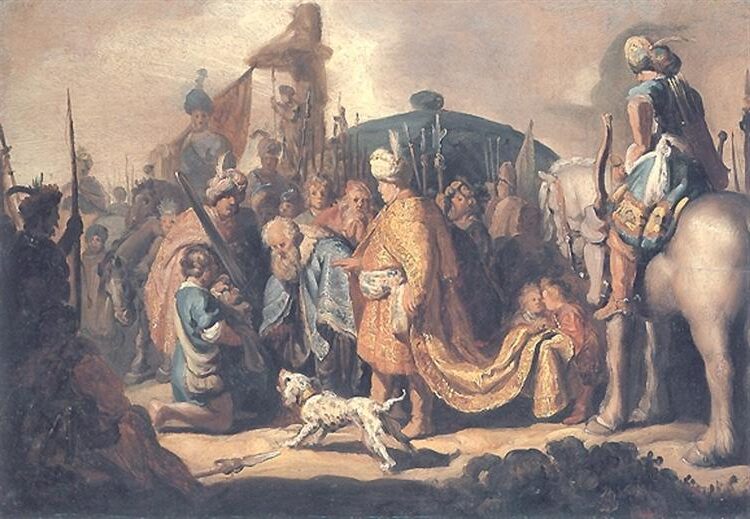
David Offering the Head of Goliath to King Saul (1627) by Rembrandt
His former neighborhood in the Jewish Quarter features historical markers and guided tours highlighting his connections to the area. The Rembrandt Route allows visitors to walk in his footsteps through 17th-century Amsterdam.
The Dutch have featured his image on their currency and stamps, solidifying his status as a national icon. In 2006, the Netherlands celebrated the 400th anniversary of his birth with a year of special exhibitions and events.
Film directors and novelists continue to explore his life in biographical works, fascinated by both his artistic genius and troubled personal circumstances. Art historians regularly publish new research, ensuring his techniques and contributions remain relevant to contemporary discussions.
Frequently Asked Questions
Rembrandt’s extraordinary artistic legacy has sparked numerous questions about his techniques, influence, and personal journey. His revolutionary approach to light, emotional depth, and technical innovations continue to fascinate art scholars and enthusiasts worldwide.
What are some of the defining characteristics of Rembrandt’s painting style?
Rembrandt’s style is immediately recognizable for his masterful use of chiaroscuro—the dramatic contrast between light and shadow. This technique creates depth and focuses attention on the most important elements in his compositions.
His brushwork evolved throughout his career, becoming increasingly bold and textured in his later works. He applied paint thickly in highlighted areas, a technique called impasto, which gives his paintings a three-dimensional quality.
Rembrandt’s psychological insight stands out in his portraits. He captured not just physical likeness but the inner emotional state of his subjects, revealing their humanity and complexity.
What influence did Rembrandt have on the art world during his life and posthumously?
During his lifetime, Rembrandt ran a successful workshop and trained many artists who spread his techniques throughout Europe. His innovative approach to portraiture and history painting challenged established conventions.
After his death, Rembrandt’s reputation fluctuated but eventually solidified as one of Western art’s greatest masters. His psychological depth and technical brilliance influenced generations of artists from the Romantic period to modern times.
His self-portraits—nearly 100 throughout his career—created a visual autobiography that inspired artists to explore self-representation as a means of artistic and personal expression.
How did the socio-economic conditions of the time impact Rembrandt’s work and artistic evolution?
Rembrandt worked during the Dutch Golden Age, a period of extraordinary wealth and cultural flowering in the Netherlands. This environment initially provided him with wealthy patrons and prestigious commissions.
Despite early success, Rembrandt faced financial ruin later in life. His bankruptcy in 1656 forced him to sell his extensive art collection and home, yet this hardship coincided with some of his most profound artistic developments.
The Dutch Republic’s merchant class created a new art market that allowed Rembrandt to explore more personal subjects beyond traditional religious and mythological themes.
Can you describe the techniques Rembrandt employed in his etchings and paintings?
In painting, Rembrandt developed a unique layering technique. He built up thin glazes of transparent oil paint to create luminosity, particularly in skin tones, contrasted with thicker impasto for highlights.
His etching innovations revolutionized printmaking. He experimented with different papers, ink applications, and plate treatments to achieve varied tonal effects unprecedented in the medium.
Rembrandt often used himself, family members, and neighbors as models. This practice allowed him to capture authentic emotions and spontaneous moments rather than idealized figures.
What was the significance of light and shadow in Rembrandt’s artwork?
Light in Rembrandt’s work serves both technical and symbolic purposes. He used directed illumination to guide the viewer’s eye to important narrative elements and create dramatic focal points.
His mastery of shadow adds psychological depth and mystery. Faces partially concealed in darkness suggest inner thoughts and emotions, inviting viewers to look deeper than surface appearances.
As his career progressed, Rembrandt’s light became increasingly spiritual. Golden illumination in his later works often suggests divine presence or revelation, reflecting his deep engagement with biblical narratives.
How have Rembrandt’s personal life events been reflected in his artworks?
Rembrandt’s paintings of his wife Saskia capture domestic happiness and prosperity. After her death in 1642, his work shows a marked shift toward greater introspection.
The deaths of three of his children and later his common-law wife Hendrickje are reflected in works of profound emotional intensity. His late self-portraits reveal unflinching honesty about aging and mortality.
Financial struggles after his bankruptcy influenced both his subject matter and technique. His later works show less concern with pleasing patrons and greater artistic freedom, resulting in more personal and experimental approaches.



